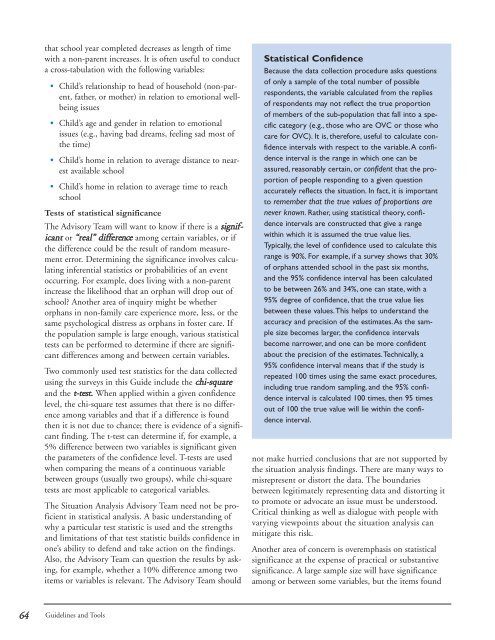Conducting a Participatory Situation Analysis of.pdf - Global HIV ...
Conducting a Participatory Situation Analysis of.pdf - Global HIV ...
Conducting a Participatory Situation Analysis of.pdf - Global HIV ...
Create successful ePaper yourself
Turn your PDF publications into a flip-book with our unique Google optimized e-Paper software.
that school year completed decreases as length <strong>of</strong> time<br />
with a non-parent increases. It is <strong>of</strong>ten useful to conduct<br />
a cross-tabulation with the following variables:<br />
• Child’s relationship to head <strong>of</strong> household (non-parent,<br />
father, or mother) in relation to emotional wellbeing<br />
issues<br />
• Child’s age and gender in relation to emotional<br />
issues (e.g., having bad dreams, feeling sad most <strong>of</strong><br />
the time)<br />
• Child’s home in relation to average distance to nearest<br />
available school<br />
• Child’s home in relation to average time to reach<br />
school<br />
Tests <strong>of</strong> statistical significance<br />
The Advisory Team will want to know if there is a significant<br />
or “real” difference among certain variables, or if<br />
the difference could be the result <strong>of</strong> random measurement<br />
error. Determining the significance involves calculating<br />
inferential statistics or probabilities <strong>of</strong> an event<br />
occurring. For example, does living with a non-parent<br />
increase the likelihood that an orphan will drop out <strong>of</strong><br />
school? Another area <strong>of</strong> inquiry might be whether<br />
orphans in non-family care experience more, less, or the<br />
same psychological distress as orphans in foster care. If<br />
the population sample is large enough, various statistical<br />
tests can be performed to determine if there are significant<br />
differences among and between certain variables.<br />
Two commonly used test statistics for the data collected<br />
using the surveys in this Guide include the chi-square<br />
and the t-test. When applied within a given confidence<br />
level, the chi-square test assumes that there is no difference<br />
among variables and that if a difference is found<br />
then it is not due to chance; there is evidence <strong>of</strong> a significant<br />
finding. The t-test can determine if, for example, a<br />
5% difference between two variables is significant given<br />
the parameters <strong>of</strong> the confidence level. T-tests are used<br />
when comparing the means <strong>of</strong> a continuous variable<br />
between groups (usually two groups), while chi-square<br />
tests are most applicable to categorical variables.<br />
The <strong>Situation</strong> <strong>Analysis</strong> Advisory Team need not be pr<strong>of</strong>icient<br />
in statistical analysis. A basic understanding <strong>of</strong><br />
why a particular test statistic is used and the strengths<br />
and limitations <strong>of</strong> that test statistic builds confidence in<br />
one’s ability to defend and take action on the findings.<br />
Also, the Advisory Team can question the results by asking,<br />
for example, whether a 10% difference among two<br />
items or variables is relevant. The Advisory Team should<br />
Statistical Confidence<br />
Because the data collection procedure asks questions<br />
<strong>of</strong> only a sample <strong>of</strong> the total number <strong>of</strong> possible<br />
respondents, the variable calculated from the replies<br />
<strong>of</strong> respondents may not reflect the true proportion<br />
<strong>of</strong> members <strong>of</strong> the sub-population that fall into a specific<br />
category (e.g., those who are OVC or those who<br />
care for OVC). It is, therefore, useful to calculate confidence<br />
intervals with respect to the variable.A confidence<br />
interval is the range in which one can be<br />
assured, reasonably certain, or confident that the proportion<br />
<strong>of</strong> people responding to a given question<br />
accurately reflects the situation. In fact, it is important<br />
to remember that the true values <strong>of</strong> proportions are<br />
never known. Rather, using statistical theory, confidence<br />
intervals are constructed that give a range<br />
within which it is assumed the true value lies.<br />
Typically, the level <strong>of</strong> confidence used to calculate this<br />
range is 90%. For example, if a survey shows that 30%<br />
<strong>of</strong> orphans attended school in the past six months,<br />
and the 95% confidence interval has been calculated<br />
to be between 26% and 34%, one can state, with a<br />
95% degree <strong>of</strong> confidence, that the true value lies<br />
between these values.This helps to understand the<br />
accuracy and precision <strong>of</strong> the estimates.As the sample<br />
size becomes larger, the confidence intervals<br />
become narrower, and one can be more confident<br />
about the precision <strong>of</strong> the estimates.Technically, a<br />
95% confidence interval means that if the study is<br />
repeated 100 times using the same exact procedures,<br />
including true random sampling, and the 95% confidence<br />
interval is calculated 100 times, then 95 times<br />
out <strong>of</strong> 100 the true value will lie within the confidence<br />
interval.<br />
not make hurried conclusions that are not supported by<br />
the situation analysis findings. There are many ways to<br />
misrepresent or distort the data. The boundaries<br />
between legitimately representing data and distorting it<br />
to promote or advocate an issue must be understood.<br />
Critical thinking as well as dialogue with people with<br />
varying viewpoints about the situation analysis can<br />
mitigate this risk.<br />
Another area <strong>of</strong> concern is overemphasis on statistical<br />
significance at the expense <strong>of</strong> practical or substantive<br />
significance. A large sample size will have significance<br />
among or between some variables, but the items found<br />
64<br />
Guidelines and Tools















